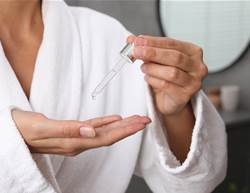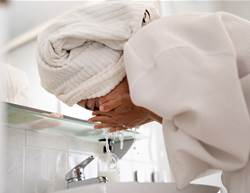When it comes to applying skincare products, your skin type matters. If you’re dealing with a dry or dehydrated complexion, experts say following a proper skincare routine for dry skin is key to boosting hydration and restoring moisture.
“Tailoring your skincare routine to your skin type ensures you’re meeting your skin’s needs. For dry skin, that means consistent use of ingredients that replenish moisture and support the skin barrier,” explains board-certified dermatologist Dr Corey L. Hartman. “The types of products and how often you apply them will differ from someone with oily skin, who would focus more on regulating oil rather than adding moisture.”
People with dry skin often struggle to keep the skin barrier strong, adds double board-certified dermatologist Dr Karan Lal. When the barrier is compromised, it can lead to inflammation, redness, itching, tightness, burning or even infection.
To help manage symptoms and soothe discomfort, dermatologists recommend following a skincare routine that’s rich in nourishing, barrier-supporting ingredients. Read on for expert tips to create a dry skin routine that works and helps you feel more comfortable in your skin.
Key ingredients for dry skin
When choosing products to add to your routine, look for the following to help manage dry skin:
- Humectants - Think of humectants as water magnets—these ingredients draw hydration into the skin from the air or deeper skin layers, making them ideal for dry skin, says Dr Hartman. Look for ingredients like hyaluronic acid, glycerin and panthenol (vitamin B5).
- Emollients - Emollients help soften and hydrate the skin by replenishing lipids, explains Dr Lal. Effective emollients include shea butter, squalane, ceramides and fatty acids, which are commonly found in moisturisers.
- Occlusives - Occlusive ingredients like lanolin, petrolatum and oils help protect the skin barrier and seal in moisture. This step is especially important for dry skin types, as it prevents hydration loss from the rest of your routine, says Dr Hartman.
- Alpha hydroxy acids (AHAs) - AHAs are chemical exfoliants that remove dry, flaky skin and support better absorption of other skincare products. Dr Hartman recommends introducing products with mandelic acid, malic acid, lactic acid or glycolic acid gradually to avoid irritation.
Skincare routine for dry skin
1. Creamy cleanser: morning and/or night
Start with a creamy, hydrating cleanser to remove makeup, dirt and oil. “Creamy cleansers usually contain moisturising ingredients that help hydrate as you cleanse,” says Dr Hartman.
If you have dry skin, you might choose to cleanse only at night. For makeup wearers, double cleansing with an oil cleanser followed by your usual face wash can help ensure every trace of product is removed.
2. Toner: morning and/or night
Toners are optional, but if you use one, apply it after cleansing and before serums or moisturisers. A good rule of thumb is to apply products from thinnest to thickest in texture.
Toners help sweep away any lingering impurities and prep your skin for the next steps. Dr Lal advises choosing a hydrating or milky-textured toner over older, alcohol-heavy versions that can strip the skin.
3. Hydrating serum: morning and night
“For anyone with dry skin, applying a hydrating serum after cleansing is a smart step,” says Dr Hartman. “Serums contain smaller active ingredients than moisturisers, which means they can penetrate more deeply.”
Stick to gentle, humectant-rich serums and avoid those with strong actives that could dry or irritate your skin.
4. Retinol: night
This is the stage to apply any targeted treatments, like retinol. While it might seem too harsh for dry skin, Dr Hartman says, “Everyone should be using retinol” as it’s “one of the most researched and most effective ingredients proven to improve skin appearance.”
Retinol helps regulate cell turnover, promotes exfoliation, improves discolouration, manages oil production and smooths fine lines and wrinkles.
If your skin is very dry or sensitive, Dr Lal recommends choosing a gentle retinol serum or an oil-based version. “Always moisturise immediately after applying retinol,” he says. “And if you’re dealing with sensitivity or flaking, try moisturising before and after—known as the sandwich method.”
5. Moisturiser: morning and night
Apply moisturiser after serum or treatment steps, both in the morning and at night. “Dry skin happens when the skin barrier is compromised,” explains Dr Hartman. A good moisturiser helps replenish hydration, strengthen the barrier and seal in the benefits of your earlier products.
Look for moisturisers that contain emollients and antioxidants for maximum hydration and protection.
6. Sunscreen: morning
Dermatologists agree—daily sunscreen is essential for healthy skin. “Choose a broad-spectrum sunscreen that protects against UVA and UVB rays,” advises Dr Hartman. Many hydrating sunscreen options are now available that suit dry skin types.
7. Face oil: night
This step is optional. For those with very dry skin, finishing your night routine with a facial oil can help lock in moisture and add extra nourishment. Oils are occlusive, meaning they form a barrier to keep hydration in.
Dr Lal suggests looking for jojoba oil, sunflower seed oil, rosehip oil or squalane. However, he cautions that some oils can clog pores in acne-prone skin, so it’s worth patch testing first or choosing non-comedogenic options.
How to treat dry skin on face
In addition to following a skincare routine tailored for dry skin, these extra steps can help manage dryness more effectively.
Drink more water
“It sounds like a cliché, but drinking more water really does help,” says Dr Hartman. “When your body is hydrated, your skin looks better too.” According to the Academy of Nutrition and Dietetics, women should aim for around nine cups of water a day and men around 13, although this may vary depending on your age, activity level and overall health.
Invest in a humidifier
Running a humidifier adds moisture to the air and can reduce transepidermal water loss (TEWL), which is key for keeping skin hydrated, says Dr Lal. He recommends using a humidifier in your bedroom overnight so your skin benefits while you sleep.
Lock moisture into the skin
Dr Lal suggests spritzing a thermal spring water spray during your skincare routine—ideally before applying moisturiser—to help seal in hydration.
Try a hydrocortisone cream
If your skin is particularly dry or flaky, Dr Lal advises using a 1% hydrocortisone ointment to calm inflammation and relieve symptoms. “Apply it twice daily until the dryness clears, then taper to once or twice a week as needed,” he says. “If that’s not enough, it’s time to see a dermatologist.”









